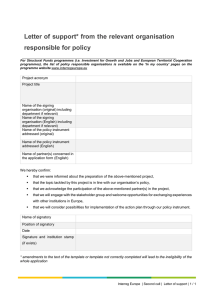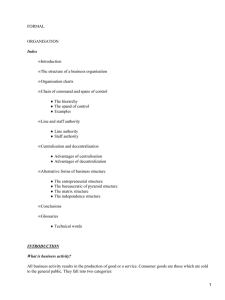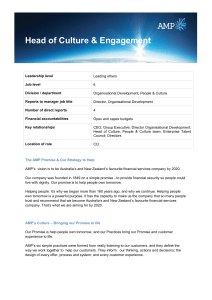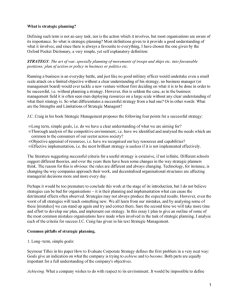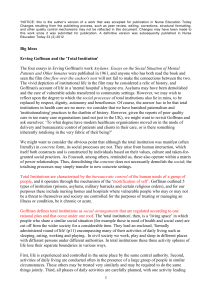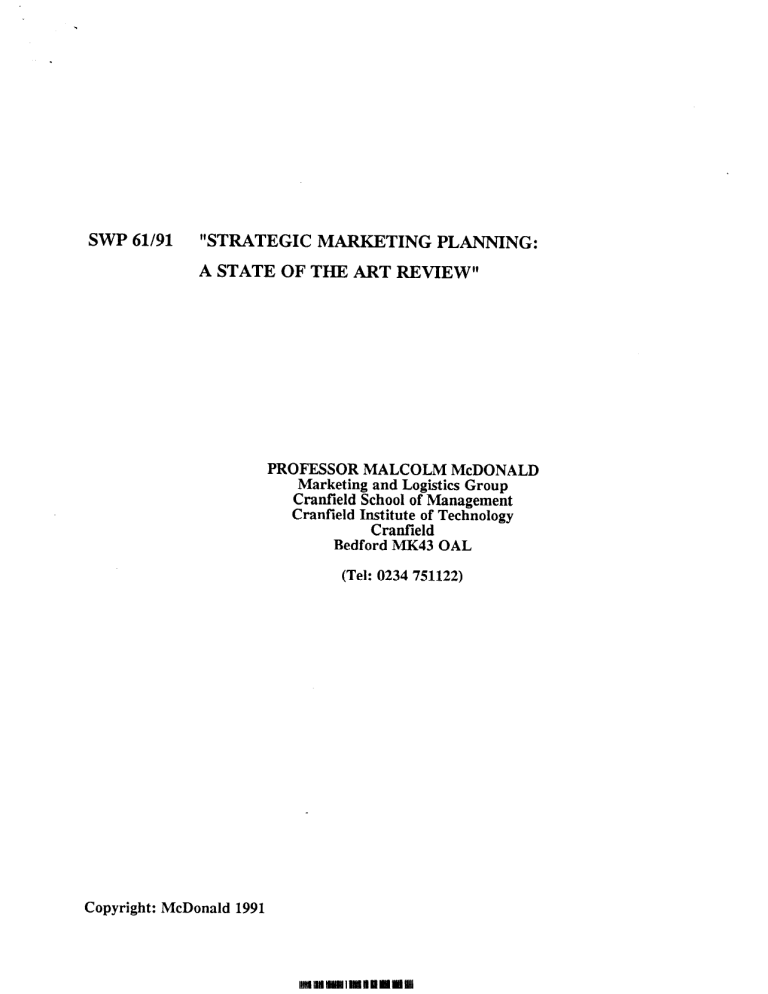
SWP 61/91
“STRATEGIC
MARKETING
PLANNING:
A STATE OF THE ART REVIEW”
PROFESSOR MALCOLM MCDONALD
Marketing and Logistics Group
Cranfield School of Management
Cranfield Institute of Technology
Cranfield
Bedford MK43 OAL
(Tel: 0234 751122)
Copyright: McDonald 1991
STRATRGIC WING
PT&NNING :
STATE-OF-THEFART n
By Professor
Malcolm H B McDonald
Cranfield
April
1991
troduction
So say
always beat a good little
'un"'.
"A good big 'un' will
They
are
the afficionados
of the noble art
of pugilism.
experience
undoubtably
correct
in what they say, because their
However, there are two very important,
confirms this to be true.
These are,
which colour this thinking.
unspoken, assumptions
that the contest is limited
to the confines of a boxing ring., and
conducted under the Marquis of Queensbury Rules.
Given these conditions,
the heavier fighter
will always triumph
David would never have been
over his lighter-weight
adversary.
able to overcome Goliath,
had such a handicap been imposed upon
Nor would Drake have defeated the vastly
superior
Spanish
him.
Armada.
Both of these apparently
disadvantaged
competitors
owed their
They refused to play the game
success to doing the unexpected.
Instead,
on their opponent's
terms and sloq it out, toe to toe.
they turned their
lack of physical
strength
into a strategic
speed of attack and surprise.
advantage of nimbleness,
In essence,
strategic
marketing
planning
is an approach
to
like
the stories
above, can enable even the
business
which,
However, as we
smallest
competitor
to survive
successfully.
is no simple
'magic formula'
which can be
shall
see, there
There is no marketing
equivalent
of Aladdin's
administered.
which
can
make
an
organisation's
dreams
come
true.
lamp,
Strategic
marketing demands a perceptive
and intelligent
analysis
The resulting
of both the company and its business environment.
plan
then requires
equal
proportions
of perspiration
and
and be brought to fruition.
inspiration
to make it come alive,
state-of-the-art
1.
and techniques
available
to
The development of the 'tools'
the strategic
marketing
planner..
The barriers
which hamper the introduction
of strategic
or serve to reduce its effectiveness.
marketing
planning,
2.
However,
marketing
review
will
before this is done, it
planning
and examine its
Nhat is Marketing
focus
on two main themes;
This
will
be necessary
'pedigree'.
to
define
Plannina?
The overall
purpose of marketing
planning,
and its principal
is the identification
and creation
of a competitive
focus,
Yet after twenty years of involvement
as a researcher
advantage.
about the subject,
the
(McDonald 1984), a teacher and a writer
1
author of this paper has experienced
little
to change his view
that marketing
planning
is still
the most enigmatic
of all the
problems facing management as they brace themselves for whatever
challenges
the coming years hold.
planning
is a logical
sequence of
In simple terms, marketing
activities
which leads to the setting
of marketing objectives
and
the formulation
of plans to achieve them. In small undiversified
companies this process, if it exists at all, is usually informal.
the process
is often
In larger
more complex organisations,
systematised.
Usually the planning
process involves
a situation
review,
the
formulation
of some basic assumptions about what constitutes
the
strengths
and weaknesses of the organisation,
a comparison with
how these weigh against the opportunities
and threats
posed by
the business environment,
setting
objectives
for what is sold and
are to be achieved,
and
how the objectives
to whom, deciding
necessary
for
the
actions
and
scheduling
out
costing
implementation.
to cope with increasing
Apart from helping
the organisation
more intense
competitive
environmental
complexity,
turbulence,
change,
a
and the sheer pace of technological
pressures,
marketing plan is useful for the organisation,
for managers, for
non marketing
functions,
and for subordinates:
to
to
to
to
to
to
to
to
to
help identify
the source of competitive
advantage:
instil
an organised approach to business development:
develop specificity;
clarify
roles and improve co-ordination:
ensure consistent
relationships:
inform;
provide a context for their
contributions:
monitor progress:
get resources;
to set
objectives
and strategies:
to inform:
to gain commitment.
Taken all round, marketing
planning appears to provide numerous
and for this reason ought to be
benefits
for the organisation,
very well accepted as part of its standard operating
procedures.
falls
far short of the truth.
However, such a state of affairs
Greenley's
recent (1987) study of marketing planning
identified
only seven UK empirically
based studies
into
the marketing
The remaining
planning
practices
of commercial organisations.
are largely
prescriptive
and amount to
mass of publications
little
more than logically
deduced theories
based on ungrounded
(what Glaser
and Strauss
(1967)
refer
to as
assumptions
Most of the empirical
studies concluded that few
"examplingW).
companies actually
practice
the theory of marketing
planning so
prolifically
written
about by so many.
But,
even more disturbing,
those
2
who recognised
the need for
a
more structured
approach to planning
their
marketing
and who
turned to the formalised
procedures found in prescriptive
texts,
claimed
benefits
of
marketing
planning.
rarely
enjoyed
the
Indeed, the very opposite sometimes happened, in that there were
which brought
marketing
actually
dysfunctional
consequences,
planning
itself
into disrepute.
This will
come as no surprise
to those keen observers who have
noted that some companies who plan their marketing meticulously,
fare badly,
whilst
their cavalier
and inept (in marketing terms)
contemporaries
do well.
It raises the question
about whether there is, or whether there
between marketing
planning
and
has ever been, a relationship
commercial success.
A recite
for
commercial
success?
The claimed benefits
of better
coordination
of inter-related
better
awareness,
environmental
improved
activities,
communication
among management, better use of resources,
and so
and there is a relationship
are there for the taking,
on, really
between marketing
planning
and commerical success, as the work
Thompson (1962) Rollatt
et al.
(1972),
of McDonald (op tit),
Ansoff (1977), Thune and House (1970), Leighton (1966) and others
problems surrounding
has shown. It is just that the contextual
the process of marketing
planning
are so complex and so little
that effective
marketing
planning
rarely
happens.
understood,
What these problems are and how they can be overcome will
be
dealt with a little
later.
The fact that financial
performance at any one point in time is
not necessarily
a reflection
of the adequacy or otherwise
of
(since some companies just happen to be in
planning procedures,
in growth industries),
the right place at the right time, usually
Those who
should not deflect
us from this fundamental
truth.
want to know what marketing planning can add in a situation
where
a company has a well established
position,
and where success to
date has not been based on any particularly
rigorous
approach to
should remember that all leadership
positions
marketing planning,
No
industry
based
in
the
United
Kingdom
should
are transitory.
The
rapid
and
systematic
demise
need reminding
of that today.
of the UK's world
leadership
position
is an insult
to the
founding fathers
of British
industry.
It is easy to forget the financially-driven
management of the 60s
and 70s who milked dry the results
of the endeavours of their
Rationality
to them meant only
entrepreneurial
forebearers.
short-term
profits
on a product-by-product
basis,
and if this
meant raising
the price or deleting
the product,
who cared as
long as the end-of-year
profit
and loss account came out right?
promotion,
share,
market
Regard for
competitive
position,
customer franchise,
R & D and the like (all of which, of course,
are funded from revenue) seemed irrelevant
in those halcyon days
of high growth.
Nor should we fool ourselves
that this sad sate of affairs
has
A recent
study (Wong, Saunders and Doyle 1988) of
changed.
Japanese and British
companies in the UK concluded that 87% of
British
firms
still
have profit
maximization
as their
major
80% of their
Japanese competitors
have
short-term
goal, whilst
It is a sad
market share growth as their major short-term
goal.
reflection
on our business schools in the UK that so many of our
top industrialists
still
behave like vandals in the way they
It is little
wonder that so many
manage their marketing assets.
of our famous industries
and names such as Woolworths,
Dunlop,
British
Leyland and countless
others,
have had to suffer
the
and it is a pity that so many more
humility
of near bankruptcy,
will have to suffer
the same fate before we come to our senses
and see that marketing
planning
is crucial
to our long-term
survival
and prosperity.
marketing's
company,
the
shape or size
of the
Whatever
success
lies
in analysing
future
contribution
to business
to meet well-defined
needs.
This means that
opportunities
products and sel-vces
need to provide the sought-after
benefits
in a superior
way to that of competitors.
Let us now turn to the question
of the techniques
which are
and
why
it
is
that
they
are often
available
to the marketer,
To
a
large
extent,
ways.
or
used
in
inappropriate
neglected,
this
is a reflection
of the marketer's
understanding
of the
theory behind the techniques.
DOES MARKETING THEORY HAVE ANY VALUE?
(1983) on applying
research to
Stephen King's sensitive
paper
decision-making
focused attention
on Britain's
lack of innovation
industrial
demise since the
as one of the key causes of Britain's
that marketing
war. His main argument centred around the belief
research
in general
had failed
to address the real marketing
issues, because so much of it is quantitative.
He covered most forms of research in his review, including
retail
choice
motivational
research,
TV ratings,
multiple
audits,
econometrics
and gap analysis,
Fishbein,
conjoint
analysis.
concluding
that they can actually
be destructive
to innovation
if applied directly
to decision
making.
"I believe
part of our national
failure
to innovate
has come
through trying
to use market research not as an aid to decision
ideally
reduces all
personal
but as a svstem that
making,
as to which of two numbers is the
judgement to a decision
larger."
In a similar
vein, Roger Evered (1981) wrote of the emerging
realisationthatthe
positivistic
science paradigm inherited
from
the physical sciences has serious shortcomings
for the managerial
and organisational
sciences,
and he concluded:
"We must move beyond the
optimising
number-oriented,
reductionist,
analytic,
objective,
and fail-safe
approach to future
4
problems,
subjective
increasing
and learn
to
synthesising,
ways.'*
think
with
holistic,
equal
fluency
quantitative,
More recently
, John Hughes (1988), in his wide-ranging
of the teaching
of management education,
concluded:
in more
optionreview
"The mistake we have made in teaching
during the past 40 years
has been to follow
the logic approach to the physical
sciences
followed
by an assumed application
in
in teaching theory first,
is too hard to
practice
. . . The bridge from theory to practice
cross without
some prior experience
of the 'other
side'...
A common theme running through the substantial
literature
on the
growing concern about the appropriateness
of the positivistic
science paradigm for understanding
the process of management, is
that much of management deals with judgement,
diagnosis,
and
which requires
a different
kind of
interpretation
of events,
knowing from logic and rationality.
Donald Schon (1984) describes
scientific
rigour as "describable,
testable,
replicabletechniques
derived fromscientific
research,
based on knowledge that is testable,
consensual,
cumulative
and
convergent, II but then goes on to argue that much of what passes
for scientific
management is irrelevant
because business problems
most marketing problems are
do not come well formed. Certainly,
practitioners
make
and successful
messy and indeterminate
Many
judgements using criteria
which are difficult
to define.
academics would decry this as a lack of rigour,
and in so doing
exclude as non-rigorous
much of what successful
practitioners
actually
do.
It is this theme which is of particular
relevance
to marketing.
in the positivistic
Moreover, it has less to do with its origin
model of science than with the failure
of the academic world to
understand better what needs to be done to bridge between theory
and practice.
THE GAP BETWEENTHEORY AND PRACTICE
it is necessary
to reiterate
that marketing
however,
First,
In
no
other
discipline
theory is not practised
in industry.
outside
marketing
is the gap between theory
and practice
so
In March 1989, Tony McBurnie (1988), Director
General of
great.
The Chartered Institute
of Marketing,
wrote:
"Research in the early
1980s showed that some two thirds
of
British
companies did not have clearly
defined market strategies
and did not use basic marketing
disciplines.ll
Almost three
quarters
of organisations
rely
principally
on
In very few
extrapolative
techniques
and financial
husbandry.
cases is it possible
to find any evidence of the use of some of
the more substantive
techniques taught on most marketing courses,
such as the Ansoff Matrix,
product life cycle analysis,
diffusion
the Directional
Policy Matrix,
of innovation,
the Boston Matrix,
5
and other
strategic
and tactical
marketing
devices.
An interesting
ADCAD (1988) was
like to make use
few did.
Nor is this
just
a European phenomenon.
conclusion
from the MS1 Expert System Project,
that although American companies would actually
of existing
theoretical
knowledge of marketing,
The most recent study
L.C. (1989) concluded:
on this
topic
by Reid,
D.M. and Hinkley,
"Respondents were asked which techniques they were familiar
with.
The results
were skewed towards ignorance of all the techniques
were not at all familiar
to which they were exposed. The majority
was
with any by name. The level of awareness of the techniques
not significantly
different
between Hong Kong and the UK."
The specific
techniques
BCG;
Directional
included:
and the Experience Curve.
Similar
findings
have also
There are numerous possible
in industry
of the everyday
example:
*
*
*
which were the
Policy Matrix;
focus
Ansoff
of the
Matrix;
study
PIMS;
emerged from Australia.
explanations
for this lack of usage
For
tools of marketing
teachers.
Companies have never heard of them:
Companies have heard of them, but do not understand them;
Companies have heard of them, have tried
them and found
that they are largely
irrelevant.
Whilst all of these (and others)
are distinct
possibilities,
it
also
that
marketing
is
not to recognise
would be naive
organisational,
involving
a political
process,
essentially
cultural
and social
issues which in themselves
interpersonal,
appear to have no existence
as observable
entities,
since they
are contextual
and are continuously
changing and evolving.
Recent research
into marketing
and corporate
culture
(Leppard
1987) goes part of the way in explaining
some of the blockages
to the implementation
of marketing theory as we shall see later.
Nonetheless there remains the question of why so many companies
that genuinely
strive
to adopt a marketing,orientated
approach
to doing business still
repeatedly
fall
back on fiscal
rather
than marketing measures to direct
and control
the business.
In
one is left wondering why companies find it
such circumstances,
so difficult
actually
to implement what is taught about marketing
in business schools.
MRKETING
TECHNIQUES/STRUCTURESCruREs/FRAWEWaRKS
Most foundation
basic
*
*
frameworks:
courses
in marketing
The Ansoff Matrix;
Market Segmentation;
6
cover at least
the following
*
*
*
Product Life Cycle Analysis:
Portfolio
Management (Boston Box and the Directional
Policy
Matrix)
Marketing research and Marketing Information
Systems.
a host of techniques revolve around the four basic
Additionally,
elements of the marketing
mix, Product,
Price,
Promotion;
and
Even a cursory glance through Philip
Kotler's
standard
Place.
marketing management text reveals a vast and complex armoury of
tools and techniques that can be used by marketing practitioners
to gain a sustainable
competitive
advantage for their product or
service.
During the past three decades, each one has been the focus of
numerous academic and practitioner
papers which have sought to
explain their complexities
and to persuade managers to adopt them
as part of the process of marketing management.
Eagerly, devotees of the 'new' message will denounce or drop all
the earlier
received
wisdom as they attempt
to force their
problems into the latest
answer. When the latest
fad fails
to
it too begins to fade into obscurity,
live up to expectations,
except at management education establishments,
where it becomes
part of the standard fabric
of teaching.
somewhat
There are, however, a number of problems with this
simplistic
explanation
of the product life cycle effect
on each
These problems revolve
firstly
of the tools
and techniques.
around methodological
problems associated
with the actual tools
and secondly with the complexity
of
and techniques
themselves,
trying
to link a number of them together.
PROBIXWSOF UNDERSTANDING
If we take a look at some of the more important
structures
and
frameworks used in marketing management, we will observe a number
in understanding,
of issues of varying
degrees of difficulty
hence in application.
There is clearly
a
The product life
cycle is a case in point.
difference
between a product
life
cycle and a brand life
cycle
It is also pointless
for a firm to draw a product
(Doyle
1989).
life cycle of one of its own products without also drawing a life
But the
cycle at least of the product class to which it belongs.
question of how to define the product class (market) to which it
Furthermore,
the linkage
belongs if fraught with difficulties.
between the product Iife cycle and the diffusion
of innovation
For example, high priced
curve needs to be properly understood.
calculators
first
diffused
through the scientific
market, then
then the business
market,
then the
the professional
market,
and finally
the school children
market.
Each
general market,
bell-shaped
diffusion
was followed by another,
each time adding
to the absolute sales curve depicted by the product life cycle,
with different
cost and strategy
implications
along the way.
Failure
to understand
basic
points
7
such as these
and others
has
destined
interested
dormant.
analysis
p.1.c.
academics.
to be a topic of interest
solely
to
In the world of business
it lies largely
Another well-known,
under utilised
and misunderstood
tool taught
policy
matrix
(McDonald
by marketing academics is the directional
for the vertical
axis (market
For example, the criteria
1990).
attractiveness)
can only be determined
once the population
of
Once determined,
those criteria
f*marketsV1 has been specified.
cannot be changed during the exercise.
Another common mistake is
to misunderstand
that unless the exercise
is carried
out twice once for t.o and once for t+3, - the circles
cannot move
Also, the criteria
have to change for every tlmarkett@
vertically.
assessed on the horizontal
axis each time a company's strength
in market is assessed.
Some way has also to be found of
quantifying
the horizontal
axis to prevent every market appearing
If we add to this just some
in the left hand box of the matrix.
of the further
complexities
involved,
such as the need to take
the square root of the volume or value to determine
circle
diameter,
the need to understand that the term "attractiveness"
has more to do with future
potential
than with any externally
and so on, we begin
to understand
why
derived
criteria,
Indeed, one cannot
practising
managers rarely
use the device.
the academics
have sufficient
wondering
whether
all
help
understanding
of all
the technique
to be able to teach it
competently.
Even Michael Porter's
apparently
more easily assimilated
matrix
describing
the relationship
between costs and degree of marketing
differentiation
has become the latest victim of misunderstanding
and abuse through ignorance
(Speed 1989).
Reid and Hinkley
(op tit)
drew the following
conclusion
from
a failure
of business schools to
their
own study. ItIt reflects
disseminate
knowledge of strategic
methodologies."
every tool
The main problem, however, is not just that virtually
and technique
of marketing
is open to serious misunderstanding
and abuse, but that no one method by itself
can deliver
the kind
Most academics
of benefits
demanded by practising
managers.
would readily
acknowledge the singular
contribution
to diagnosis
irrespective
of whether it is
that can be made by each device,
from the school of life or the more rigorous
academic school. For
example, whilst
it is easy (and tempting)
to dismiss most of what
Tom Peters had to say (1982) (largely
because of its lack of
few would deny his contribution
to marketing by dint of
rigour),
the attention
he focused on the need to service the needs of our
anyone who tries
to run their
Likewise,
customers effectively.
company just on the basis of what Michael Porter
says, soon
discovers the inherent inadequacies
of the nostrum, just as those
did who worshipped at the altar of Bruce Henderson and the Boston
Consulting
Group in the late 1960s and the early 1970s. Yet few
would deny the abiding relevance to business in the 1990s of what
researches
and teachers had to offer.
all these great writers,
To summarise,
not
only
are
most
8
of
the
tools
and techniques
themselves
inherently
complex (and therefore
misunderstood
but no one tool on its own is adequate in dealing
misused),
the complexity
of marketing.,
and
with
PROBLEXS OF TECHHIQUE INT ERR0aATIONSHIPS
There is then, clearly
a need to be able to use a number of these
tools
and techniques
in problem-solving,
especially
when a
process as complex as strategic
marketing planning is concerned.
This raises
an additional
dimension
of complexity
for both
academics and practising
managers, for it then becomes necessary
to understand not only the techniques
themselves,
but the nature
of the interrelationships
between them, how inputs for one mode
can also be used for another and how outputs from some models can
also be used as inputs to others.
The problem is that the human mind just isn't
capable of dealing
This view has gradually
emerged
adequately with such complexity.
as a result
of working on a computer-based
Expert System for
(McDonald 1989) and is confirmed
Strategic
Marketi.?g Planning,
including
most recently
Lock and
by a number of researchers,
Hughes (1989).
A DIFFERENT APPROACH IS REQUIRED
in the process of constructing
the Expert System for strategic
it became clear that what was needed was some
marketing planning,
system to link the numerous artifacts
of marketing
in such a way
that outputs from one technique
could be used as inputs to other
This was indeed the missing link,
as in books and in
techniques.
the
process
of marketing
paper-based marketing planning manuals,
planning had of necessity
to be iterative,
with the onus resting
on the user to understand
the interrelationships
between the
techniques
used.
The route
Figure 1.
to this
discovery
was the
INVOLVEMENT
IN MARKET
SNAPSHOT
Data Model represented
in
’ t Score on MAF 5
md ovelall score
IN MARKfT
MARKET
Al-fRACWENESS
FACTORS
CRITICAL
5uccEss
F4ClOR.S
l
Marlre
l
Rce
l
saler
Share
Volume
Figure 1
Simplified
data model, in entih-relationship
notation
Here, the basic model consists
of a Strategic
Business Unit (SBU)
(which can be anything
from a corporate
headquarters
to an
which is involved
in a number of markets,
individual
product),
and for which it produces a number of products
(or services}.
The system starts
with the definition
of a mission
(or purpose)
statement for the SBU and indicates
very clearly
the acceptable
structure
and content of such a document.
The next stage in the process was the definition
of the contents
of a strategic
marketing
plan and the listing
of some of the
principal
tools and techniques
which may be relevant
to each of
It will be seen from Figure 2 that some of
its component parts.
these techniques
may be used for several
parts of the plan.
However, this does not delineate
sufficiently
clearly
the nature
so
it
was
necessary
to
of the. technique
interrelationships,
process
involved
in the
define
in more detail
the actual
preparation
of a strategic
marketing
plan.
Figure
3 indicates
the key steps in the preparation
of a
strategic
marketing
pian and some of the subsidiary
tasks that
have to be completed at each stage.
with it a
Each one of the boxes on the Vree*' has associated
number of marketing
tools and techniques,
so the next task was
to allocate
these to each of the main stages in the process.
10
Figure
2
I
What should appear In a three-vear
(or longen strategrc marketmg
plan
I
Marketmg
(structures.
btarkettne
~ Market
l
j
Mtsston
tarket
.
*
Kev market segments
Gap analysts
------
Issue management
(Bv product)
(Bv segment)
tOverall)
Strengths
Weaknesses
qI
Issues to be
addressed
___________----------Pomolto
0
________------------;
t=
Market segmentatton
studtes
Gap analvsrs
Product ltte cvcle analysts
Diftuston
ot rnnovatton
Anson matnx
Forecastmg
Market research
gctyre
~~v~~~~l
________------------t
0
1 cd;;:;;;
overvrew
_-____--1
I
____-_---w--e--
_____
1
summary
[
a
audit
research
statement
Financtal
___________---------------
l
models)
------
_--e-----w-
--_--_---
theorv
rrameworks.
-----n
(By product)
IBv segment)
: lOverall
summarv
---BCC matnx
Directtonal
oolrcv
1
----1
I
Assumprtons
Downstde
rISk
matnx
assessment
________-__--------------0
1
Markettng
IOverall
CBv product)
IBv segment1
obtectrves
-+
)
)
I
1-w
-
Porter matnx
Anson matnx
BCC matnx
Dtrecttonal
poltcv
Gap analvsls
Strategtc iocus
Product mtx
Product development
Product deletton
Market extensron
Target customer groups
matnx
____________-_---_-------0
1
Markettry
(4 x PSI
rPostttonrn~brandtngr
strateges
/
i
/
IL
Product
Pnce
Promotron
Place
- - -
Market segmentation
Market research
Response elasttctttes
- - ‘Blake
*McDonald
producttvrtv
Mouton
matrtx
_______------_-----------0
1 Resource
requtrements
Forecasttns
BudRetinR
1
11
studres
mafnx
1
figure 3
Figures 4, j, 6 and 7 lndlcate the relationships
the several techniques
of marketing at selected
the process or markettng
planning.
between
stages in
) Figure 4
L
12
IONDUCT
AUDIT
-
ASSESS
5TRENGTHS
AND
WEAKNESSES
hssE5s
_
OPK3RTlJNlTlES
AND
THREATS
-.__
At the focus stage (Figure
4), for example, the output
is a
statement
of those elements of the SBU selected
for analysis.
law is clearly
relevant,
as
In arriving
at this focus, Pareto's
are market seqmentation
studies
(the SIC is provided
in the
system as a possible
starting
point
for
market
computer
Porter's
cost/differentiation
matrix may also be
segmentation).
useful at this stage if there is a need to have a balance between
niche type
high volume, low cost markets and more differentiated,
The product
life
cycle could clearly
be useful
in
markets.
helping decide which markets appear more attractive,
as could a
The Ansoff Matrix
knowledge of the cost impact of experience.
is also included here because product market data associated
with
13
each of the four
between existing
boxes could be useful
and new activities.
Figure 7
Fimre 6
OlRE’.XONAl
l
14
in indicating
the balance
The purpose of the Audit Stage (Figure 5) is to complete an indepth diagnosis
or analysis
of the selected
products
and/or
Provided
here are several
markets
from the Focus stage.
The Porter five force model
checklists
to help the program user.
provide
useful
guidelines
at this
stage.
may, for example,
Detailed
instructions
on how to construct
tables
for critical
instructions
success factors
are given, as well as methodological
on how to deal quantitatively
with external
opportunities
and
threats.
The Audit
Stage has to be summarised (Figure
6) and here the
Boston Matrix
and the Directional
Policy Matrix
can be useful
pictorial
representations
of the current
product/market
status.
Each one of these techniques
emphasises different
aspects
of the
same situation.
Likewise,
Gap Analysis provides a visualisation
in summary form of the revenue and cost implications
of current
strategies.
It will
be seen that the same tools
can also be used in the
except that this time they are
Objectives,
process of Setting
extended to indicate
the desired
position
at some designated
point of time in the future.
Figures 8, 9 and 10 indicate
themselves.
relationships
Figure 8 shows the relationship
techniques
and their relevance
Figure 1.
Figures 9 and
between the
I necessary to
connections,
main ones.
between the techniques
between some of the principal
to the basic Data Model given in
10 are attempts to indicate
some of the connections
actual
techniques
themselves.
Whilst
it
is not
take the reader through every one of these interit would be useful to highlight
at least some of the
The Directional
Policy Matrix can be seen to be a central
tool
in strategic
marketing planning
(Figure 9). Life Cycle Analysis
in revenue/volume
terms for the
will
indicate
the prospects
individual
products/markets
that are plotted
on the vertical
The cost/experience
curve of individual
products/markets
axis.
will provide valuable input to both the Boston Matrix and to the
which will
in turn help in
Porter cost/differentiation
matrix,
the market
attractiveness
factors
and critical
determining
success factors
which are the basis of the Directional
Policy
Matrix.
The reader is advised to study these figures
very carefully.
This advice is given because the Expert System manages these
interrelationships
on the computer and users (typically
marketing
managers) do not have to concern themselves with them.
15
Figure 8 Technique interrelationships
I
DATA USED BY TECHNlQUEs
The dyyam
below shows the data used as input
the techmques
modelled.
bv some of
0 Market attmctwene5s
factors tMAFs)
m
I
. c.a.r:s
.l .
(actual or poten{raf,
=._
I
’I
1’ competitor)
0 Plannqz
penod
’
0 Relation to
structure
/ 1
PRODUCT K>R
MARKET
l flewtexnttng...
l pnce/average
price.
0 bales volume
I1; :’:
3 I” .‘:’ ’
is sold
rnto
@&pq
[zg;!“#/
(self or competftod
16
a practising
market ing
On the other hand, if you are either
you
would
be
advised
to dev pate
manager or a marketing
lecturer,
i of
some time to thinking
firstly
about the technical
dimensions 'es,
of
marketing
themselv
tools
and techniques
the principal
the
secondly about their specific
applications,and
thirdly
about
of
interrelationships
between these techniques
in theof process
!gic
strate
solvinu
of some of the more abiding
problems
marketing
planning.
Figure 9 Tecimiquc Intemlationships
Diagrams
between
technique.
(1)
by some
9 and 10 show vanous connections
ldenthed
techmques.
They
assume
that
bv using
a
any data required by it IS entered into themodel
x
+
so that
data
DIRECT IONAL
FOLK3 MATRIX
X
dmemnnmn
rid m l-ng
means,
technique.
10
7
IL.
w
: provides
IL
17
x as input
cos7
fXRRltNCt
CURVE
to
is available
tor
another
Fip.T
I
10 ?e&nique
interrelationships
(11)
dwmxmul
pokv pJldeltn0
CONCLUSIONSREGARDINGMARKETING 'TECHNIQUES
The only reasonable
conclusions
to reach from the foregoing
are:
better
themselves
of
avail
must
mangers
of
the
application
of
in the understanding
techniques
to real world problems;
i)
practising
education
marketing
ii)
there are enough marketing
techniques
available
already,
need to seek out newer and even more
the
without
sophisticated
approaches:
iii)
the human mind is largely
incapable
of understanding
and
managing the complexities
of the relationships
between the
many techniques
of marketing:
iv)
in view of iii)
above, expert
systems will
need to be
developed so that these complexities
are managed by the
computer in a way which is helpful
to practising
managers
in solving
their complex problem.
underlying
techniques,
the
on marketing
section
In this
implication
is that if the marketing
'champion'
is the 'doctor',
whose job is to bring the company back to health,
then he would
need to know not just about 'medicines'
(the techniques),
but
about the 'patient'
(the organisation).
The likelihood
of there being a mis-match between the two bodes
that is what often happens.
ill for the patient,
yet in reality,
18
marketing
techniques
are
All
It is easy to see why.
In contrast,
the
essentially
rational
in their
construction.
made up as it is of people with all their
human
organisation,
qualities
and frailties,
despite appearances,
is often far from
being rational.
The marketer is indeed very much like the physician
described by
about which he knows little,
into
"He pours potions,
Voltaire
people, about whom he knows even less."
In reality
many of the barriers
to marketing
It is as if its anti-bodies
the organisation.
the marketing
germ from catching
hold.
planning
come from
fight
to prevent
ORGANISATIONAL BARRIERS TO STRATEGIC MARKETING PmNINC
Chinese philosopher
is quoted as saying "Even the longest
It was never
journey must start
with a single,
small,
step."
envisaged that the step itself
constituted
the whole trip,
it was
merely a temporary position
en-route.
A
many companies don't plan where they are going,
Unfortunately,
of taking
one step, then look around
they do the equivalent
Sometimes, this journey is in the same
before taking another.
having
a
Without
even backwards.
sometimes
direction,
is relatively
unimportant.
destination
to aim for, direction
one's long term
Nobody will
claim that it is easy to identify
The task is made
strategic
objective,
say, three years hence.
Yet
extra difficult
by the turbulent
times in which we live.
the next one year step is likely
to be
without
doing this,
irrelevant
to the longer term interests
of the Company.
Most
It is easy to understand
the appeal of short-termism.
managers prefer to sell the products they find easiest
to sell
to those customers who offer
the least line of resistance.
By
tactical
marketing
plans first
and then
developing
short-term,
extrapolating
them, managers merely succeed in extrapolating
It is a bit like steering
from the wake
their own short-comings.
but not so sensible
in busy and
- 0.K in calm, clear waters,
Preoccupation
with preparing
a detailed
one year
choppy waters!
plan first
is typical
of those many companies who confuse sales
forecasting
and budgeting with strategic
marketing planning - in
our experience
the most common mistake of all.
companies led by chief
executives
with a proactive
Already,
orientation
that stretches
beyond the end of the current
fiscal
visibly
better
than the old
year have begun to show results
reactive
companies with only a short-term
vision.
Figure 10 shows the old style
attention
is paid to strategy
will be seen that lower levels
whilst
the directors
at all,
of company in which very little
by any level of management.
It
of management do not get involved
time on
spend most of their
19
operational/tactical
issues.
Strategic
Orientation
Tactical,
short
term orientation
\ .\
FIG.
FIG.
10
11
a similar
management
Figure
11 shows another
company with
Here,
The difference
between the two is striking.
hierarchy.
instead of the strategic
orientation
just constituting
a small
levels
of
of the Chief
Executive's
job f many lower
part
management are also involved
in strategy
formulation.
The lesson
to be learned
is simple:
THIS REQUIRES
DEVELOP THE STRATEGIC MARKETING PLAN FIRST.
GREATEREMPHASIS ON SCANNING THE EXTERNAL ENVIRONMENT, THE EARLY
IDENTIFICATION OF FORCES EMANATING FROM IT, AND DEVELOPING
APPROPRIATE STRATEGIC RESPONSES. ALL LEVELS OF MANAGEMENTSHOULD
BE INVOLVED IN THE PROCESS.
STRATEGIC PLAN SHOULDCOVER A PERIOD OF BETWEEN3 AND 5 YEARS,
ONLY WHENTHIS HAS BEEN DEVELOPEDAND AGREED, SHOULDTHE ONE YEAR
OPERATIONAL PLAN BE PUT TOGETHER. NEVER WRITE THE ONE YEAR PLAN
FIRST AND EXTRAPOLATEFROM IT.
A
2.
ETING FUNCTION FROM OPERATIONS
of marketing
One of the most common causes of the failure
that
marketing
is something
that
a
planning
is the belief
The appointment
of a
office.
marketing
person "doesI in their
marketing
supremo is often a last-ditch
attempt to put things
right when all else has failed.
The trouble
is, the new person
of their
knowledge or skills,
comes along and, irrespective
in others,
the
power is vested
quickly
finds
that
all
development
(the technical
people),
particularly
for product
price
(the accountants),
customer
service
(the distribution
This leaves some
department)
and selling
(the sales director).
bits of the promotional
mix for the new person to play around
Hence the new executive
is powerless to influence
anything
with.
of significance
and quickly
fails.
20
Line managers look on the new department
with disdain
and see
requests
for
information,
strategies
and plans
as a timeconsuming task likely
to have little
impact on their
real and
more pressing
problems.
This has much to do with the general misunderstanding
about what
Without a corporate
driving
force centred
marketing really
is.
(i.e.
a marketing
orientation),
around customer satisfaction,
arguments about where to put marketing
are of course pointless,
into a realisation
of the
but even when top management is jolted
mistake
need to take account of the customer, the most frequent
is to separate out marketing
from operations
as if it had the
plague.
This is not 'the place to argue about organisational
issues, such
centralisation
versus decentralisation,
as line versus staff,
although the principles
are clear:
FOR THE PURPOSEOF MARKETING PLANNING, PUT MARKETING AS CLOSE AS
POSSIBLE TO THE CUSTOMER. WHEREPRACTICABLE, HAVE BOTH MARKETING
AND SALES REPORT TO THE SAME PERSON, WHO SHOULD NOT NORMALLY BE
THE CHIEF EXECUTIVE OFFICER.
3.
CONFUSION BETWEENTHE MARKCONCEPT
MARK-
The author's
close contact
with about 2,000 senior
year confirms his belief
about the depth of ignorance
abounds concerning
what marketing
it.
managers a
that still
a)
One managing
Confusion with sales
announced to the asiembled
seminar
time for marketing
in my company
Confusion with sales is still
one of
to overcome.
b)
The belief
that all a
Confusion with product manaaement
company has to do is to produce a'good product to succeed
Concorde,
the EMI bodyalso still
abounds, and neither
thousands
of
brilliant
British
nor the many
scanner,
products
that
have seen their
owners or inventors
go
will convince such people otherwise.
bankrupt,
c)
This is another popular misConfusion with advertising
are replete
with
conception
and the annals' of business
and British
Airways
examples such as Dunlop, Woolworths
who, before getting
professional
advertising
management in,
won awards with their
'brilliant,
campaigns, whilst
failing
expenditure
at
to deliver
the goods. Throwing advertising
a very popular way of tackling
deep-rooted
them, is still
marketing
problems.
d)
I;0nfuslon
.
director
aggressively
l'There,s
no
audience
,til
sales
improve!t1
the biggest
barriers
The "have a nice day"
W’
day in many countries
syndrome is currently
having its'hey
of the world, popularised
of course by Peters and Waterman
The banks are amongst those
in "In Search of Excellence".
21
who have spent millions
training
their staff to be charming
basic
getting
the
offer
whilst
still
customers
to
closed when the
fundamentally
wrong, - the banks are still
Likewise,
in British
Rail,
public
most needs them open.
whilst
it helps to be treated
nicely,
it is actually
much
more important
for passengers to arrive
on time.
The principle,
then,
is as follows:
MARKETING IS A MANAGEMENTPROCESSWHEREBYTHE RESOURCESOF
THE WHOLEORGANISATION ARE UTILISED TO SATISFY THE NEEDS OF
SELECTED CUSTOMERGROUPSIN ORDERTO ACHIEVE THE OBJECTIVES
OF BOTH PARTIES. MARKETING, THEN, IS FIRST AND FOREMOSTAN
ATTITUDE OF MIND RATHER THAN A SERIES OF FUNCTIONAL
ACTIVITIES.
4.
~UC'I'URAL
BARRIEm
Closely linked with the issue of marketing
issue of orgzz..nisational
form or structure.
powerlessness,
is the
The most typical
organigram
is the one which is based around
functions
such as personnel,
finance,
production,
corporate
Whilst the traditional
distribution,
operations,
and marketing.
reasons for this type of organisation
are clear,
there is little
doubt that it can be very difficult
to get people who are loyal
to their own "tribe"
to think of subjugating
their own goals to
the broader goals of customer satisfaction.
This is clearly
the
role of top management and has a lot to do with corporate
to be discussed below.
culture,
Whilst the team building
approach has gone a long way towards
overcoming
this
kind of organisational
barrier,
of much more
is to get the task of defining
strategic
business
importance
units (SBUs) right
(The Strategic
Planning Institute
1986).
A strategic
business
unit:
*
will have common segments
products
*
is a competitor
*
is a discrete,
*
will have a manager who has control
critical
to success
and competitors
in an external
separable
for
most of
its
market
and identifiable
unit
over most of the areas
But SBUs 'are not necessarily
the same as operating
units,
and the
be applied
all the way down to a
definition
can, and should,
particular
product of customer or group of products or customers,
and it is here that the main marketing
planning task lies.
organisational
of getting
The problem
remains
commitment to the marketing
planning
process,
discussed later.
22
support
but this
and
is
.
ORGANISE COMPANYACTIVITIES AROUNDCUSTOMERGROUPSIF POSSIBLE
RATHER THAN AROUND FUNCTIONAL ACTIVITIES AND GET MARKETING
W ITHOUT
PLANNING DONE IN THESE STRATEGIC BUSINESS UNITS.
CORPORATE
MARKETING
EXCELLENT MARKETING PLANNING IN SBUs,
PLANNING W ILL BE OF LIMITED VALUE.
5.
Even from well-respected
companies, the most common complaint
information
for
the purpose
of
lack
of adequate
concerns
On deeper investigation,
however, it nearly always
analysis.
turns out to be a case of too much information
rather than too
The real problem is frequent
lack of proper analysis.
little.
At a recent conference for a builder's
merchanting
company that
had increased
its net profit
before tax by 60% for the second
one of their
chief
executives
did not know the
year running,
answer to any of the following
questions:
How much of the profit
*
*
*
*
*
increase
is due to:
market size growth?
market share growth?
price increases?
cost reductions?
productivity
improvements?
it is clear what will happen
Faced with such massive ignorance,
industry
trading
company
the
moment
construction
to this
conditions
worsen.
The methodology for developing marketing intelligence
systems has
been comprehensively
covered in the literature
during the past
twenty years, yet it is clear that in Britain
at least,
industry
concerning
has a long way to go to get even the basics right
trends in:
*
*
*
*
the environment
markets
competitors
internal
strengths
and weaknesses
even if an organisation
has an adequate
It is also clear that,
is there a formal marketing
audit
intelligence
system, rarely
undertaken
by all SBU managers as a required
activity
at a
specific
time of the year as part of an agreed planning process.
The principle,
then
is as follows:
FOR AN EFFECTIVE MARKETINGAUDIT TO TAKE PLACE:
*
CHECKLISTS OF QUESTIONS CUSTOMISEDACCORDINGTO LEVEL IN
THE ORGANISATION SHOULDBE AGREED
*
THESE SHOULD FORMTHE BASIS OF THE ORGANISATION'S M.I.S.
*
THE MARKETING AUDIT SHOULD BE A REQUIRED ACTIVITY
23
*
MANAGERSSHOULD NOT BE ALLOWEDTO HIDE BEHIND VAGUE TERMS
LIKE "POOR ECONOMICCONDITIONS"
*
MANAGERSSHOULD BE ENCOURAGED
TO INCORPORATETHE TOOLS OF
MARKETING IN THEIR AUDITS, E.G. PRODUCT LIFE CYCLES,
PRODUCTPORTFOLIOS, AND THE LIKE
6.
g
Confusion between the management process itself
and the output
of the process, the marketing plan, is common. In most cases,
plans are too bulky to be of any practical
use to busy line
which
managers and most contain masses of data and information
system or
rightly
belongs in the company's marketing information
audit,
and whose inclusion
in the marketing plan only serves to
rob it of focus and impact.
The SWOT device
(Strengths,
Weaknesses,
Opportunities
and
whilst
potentially
a very powerful
analytical
device
Threats),
objectives,
strategies
to give impact to the ensuing assumptions,
and budgets, is rarely used effectively.
A SWOT Should:
*
Be focused on each specific
to the organisation's
future
*
Be a summary emanating
*
Be brief,
*
Focus on key factors
*
and
strengths
List
differential
focusing on competitive
competitors,
*
List
*
Identify
and pin down the real
list
of unrelated
points
*
The reader should be able to grasp instantly
the main
even to the point of being able to
thrust
of the business,
write marketing objectives
*
Follow the implied question
the real implications
interesting
key external
segment of crucial
from the marketing
importance
audit
and concise
only
opportunities
weakness vis
advantage
and threats
issues.
It
a
vis
only
should
Ifwhich means that
not be a
..?"
This leads to a key point which needs to be made about this
part of the marketing planning process.
To get
vital
INFORMATIONIS THE FOUNDATION ON WHICH A MARKETING PLAN IS BUILT.'
TION (INTERNAL AND EXTERNAL) COMES~~HZLIGENCE.
FROM INF'ORMA
IS THE
INTEIJJGEMCE DESCRIBES THE MARKETING PLAN,
INTELLECTUALISATION OF HOW MANAGERS PERCEIVE THEIR OWN POSITION!
IN THEIR
MARKETS RELATIVE
TO THEIR
24
COMPETITORS
(WITH
COMPETITIVE~
I
1
ADVANTAGEACCURATELYDEFINED - E.G. COST LEADER, DIFFERENTIATION,
NICHE), WHATOBJECTIVES THEY WANTTO ACHIEVE OVER SOMEDESIGNATED
PERIOD OF TIME, HOW THEY INTEND TO ACHIEVE THEIR OBJECTIVES
(STRATEGIES), WHAT RESOURCESARE REQUIRED, AND WITH WHAT RESULTS
(BUDGET).
7.
CK OF KNOWLEDGEAND SKIT
of great disappointment
to
As we have seen, it is a matter
academics that many of the components of a typical
marketing
syllabus
are rarely
used by practising
marketing
managers, at
leastin
industrial
goods organisations.
Indeed, in the author's
even experienced
marketing
managers with marketing
experience,
qualifications
often fail
to apply the techniques
of marketing
in their
jobs.
The perennial
problems
have always centred
around customer
and indeed these are extremely
behaviour and market segmentation,
Even
difficult
concepts to grasp even at the cognitive
level.
more worrying,
however is the blind assumption often made by top
all
the key marketing
practitioners
in an
management that
organisation
actually
possess both the knowledge and the skills
to be effective
marketers.
The author has conducted a series of experiments
in some of the
UK's leading companies during the past two years, and has found
that almost two-thirds
of marketing practitioners
do not know the
difference
between a corporate
objective,
a marketing objective,
Even fewer know what a logarithmic
and an advertising
objective.
and
scale
is and how it can be used in experience
curves
Very few have heard of the Standard
Industrial
matrices.
Very
Classification
and virtually
no one has heard of P.I.M.S.
few even understand
the significance
of Benefit
Analysis,
let
Out of fifty
questions,
the average
alone Benefit Segmentation.
score is about 20%.
it
Whilst these are only examples, and do not prove anything,
seriously
about
must be a matter
of concern when thinking
for without an understanding
of at least some
marketing planning,
the chance of coming up with
of the basic tools of marketing,
strategies
based on sustainable
competitive
advantage is slim.
Communication and interpersonal
skills
are also prerequisites
for
marketing plans will
marketing planning success, since excellent
of
those
on whom the main burden
be ineffective
unless
lies
understand
them and are highly
motivated
implementation
towards their
achievement.
The principle
then
is:
ENSURE ALL THOSE RESPONSIBLE FOR MARKETING IN SBUs HAVE THE
NECESSARY MARKETING KNOWLEDGEAND SKILLS FOR THE JOB.
IN
PARTICULAR, ENSURE THEY UNDERSTANDAND KNOWHOWTO USE THE MORE
IMPORTANT TOOLS OF MARKETING, SUCH AS:
*
INFORMATION
* HOW TO GET IT
25
* HOW TO USE IT
*
POSITIONING
* MARKET SEGMENTATION
* ANSOFF
* PORTER
*
PRODUCTLIFE CYCLE
ANALYSIS
* GAP ANALYSIS
*
PORTFOLIO MANAGEMENT
* BCG
* DIRECTIONAL POLICY MATRIX
*
4 X Ps MANAGEMENT
*
*
*
*
PRODUCT
PRICE
PLACE
PROMOTION
ADDITIONALLY, MARKETING PERSONNEL REQUIRE COMMUNICATION AND
INTERPERSONAL SKILLS.
8.
CK OF A SYSTEMATIC APPROACHTO WING
PLANNING
Gorb (1978) talks about the differences
between a hunter and a
farmer in planning
requirements.
A hunter travels
light,
and
needs stealth,
cunning and know-how, whereas a farmer needs to
interpret
demand for the
plan ahead, buy seed, sow, harvest,
then, at the entrepreneurial
end of
crops, and so on. Clearly,
corporate development,
marketing planning as a formalised
system
is not likely
to be seen as relevant
because of the "here and
nowI' ethos.
Leppard (1987) discusses the different
kinds of planning
system
These range from very
that are required
by organisations.
informal
systems to highly
formalised
ones, with the degree of
autonomy at the top or bottom depending on the organisation's
He also devised an analytical
size and stage of development.
tool for measuring an organisation's
stage of development
to
ensure that any marketing
planning
system is appropriate.
is that
for all
but very small,
The point
here,
however,
a marketing
planning
system is
undiversified
organisations,
essential
to ensure that things happen when they are supposed to
happen and that there are at least some basic stahdards
which
In the author's
experience
even where
must be adhered to.
and usefulness
of SBU
training
has been carried
out, the quality
marketing
plans
are so variable
as to make headquarters
coordination
into a central
document an impossible
task. This is
largely
due to the different
levels of intellect
and motivation
of participating
managers.
IT IS ESSENTIAL TO HAVE A SET OF WRITTEN PROCEDURESAND A WELLARGUED COMMONFORMAT FOR MARKETING PLANNING, THE PURPOSES OF
SUCH A SYSTEM ARE:
1.
TO ENSURE ALL KEY ISSUES ARE SYSTEMATICALLY CONSIDERED.
2.
TO PULL TOGETHER THE ESSENTIAL ELEMENTS OF THE STRATEGIC
.
PLANNING OF EACH SBU IN A CONSISTENT MANNER.
3.
TO HELP CORPORATEMANAGEMENT
TO COMPARE,DIVERSEBUSINESSES
AND TO UNDERSTANDTHE OVERALL CONDITION OF AND PROSPECTS
FOR THE ORGANISATION.
9.
FAITURE TO PRIORITISE OBJECTIVES
Even when organisations
are successful
in producing well reasoned
it is not uncommon to find in each marketing
marketing
plans,
plan as many as fifty
objectives
and many more strategies.
This
is because of the hierarchy
effect
of a principal
marketing
objective
leading to a number of sub-objectives,
which each of
It is
these sub-objectives
leading to further
sub-objectives.
to
find
any
kind
of
prioritisation
of
these
however,
rare,
and
even
rarer
to
find
any
allocation
of
time
objectives,
The
result
is
that
managers
can,
and
do,
get
resource to each.
sucked into -the day-to-day
"In Tray" syndrome, which in turn
results
in the creeping non-implementation
of the marketing plan.
The key role of senior management is to concentrate
lower level
management attention
on factors
that are both high leverage and
actionable
in order to get the essential
jobs done effectively.
To prevent managers getting
side tracked by trivia,
the author
has found that it is helpful
to get managers to prioritise
their
This is
next year's objectives
using a time allocation
planner.
illustrated
in Fig. 12.
Minor
IMPACT
Significant
Major
LOW
MEDIUM
URGENCY
37
HIGH
Q
OURCE ALLOCATION f-61
1 -30
2 -15
3 -12
-
I
4-12
5-10
68
-
then
-
8
4
1
13
-
30
-
57
-
FIGURE 12 Objectives
The principle
789-
priority
matrix
is as follows:
ENSURE THAT ALL OBJECTIVES ARE PRIORITISED ACCORDING TO THEIR
IMPACT ON THE ORGANISATION AND THEIR URGENCYAND THAT RESOURCES
ARE ALLOCATED ACCORDINGLY.
10.
HO+-
CORPORATECUIaTURES
carried
out a
During the years 1985 and 1986, Leppard (op tit)
an
explanation
for
the
research
study to attempt
to provide
This
widespread
corporate
resistance
to marketing
planning.
of marketing
planning
is largely
showed that the acceptance
conditioned
by the stage of development of the organisation
and
the behaviour of the corporate
culture
carriers.
Thus it is that
different
modes of marketing planning became more appropriate
at
different
phases of an organisation's
life.
That organisations
experience
different
phases of life
and that each phase has a different
grow and mature,
can be explained
briefly
as follows.
force',
as they
'life-
an organisation
is a man-made product,
and like all
Essentially,
useful
life
cycle.
other products
is subject
to have a finite
Equally,
the organisational
life cycle can be extended, if it is
Therefore
just as with products or services.
managed astutely,
it is important
to recognise when corrective
action is required
and the nature of the appropriate
to renew the organisation,
action to take.
All organisations
start life because somebody had a 'good idea'
and the wherewithal
to bring it alive.
Sometimes the business
idea proves to be the proverbial
lead
balloon and doesn't get off
However,with
good fortune,
a following
wind and
the ground.
can grow and thrive.
sensible
management, the organisation
seeds of
the
with
it
carries
success
its
Indeed,
very
because inevitably
the organisation
outgrows the
destruction,
capabilities
of the entrepreneur
who gave it birth
and was the
an
extra
customer,
One
day,
single
'big brain'
running things.
another
machine
in
the
factory,
one
extra
an additional
order,
The
becomes
the
straw
to
break
the
camel's
back.
employee,
28
erstwhile
busy owner manager becomes over-loaded
the organisation
stalls
As a result,
longer cope.
into a tail-spin.
(Fig. 13).
Growth
and
Maturity
Fig.
~q'?;:p
13 - The developing
and can no
and can go
Time
organisation
- the initial
life
phase
The solution
to the problem would be for the owner-manager to
take on some specialist
staff
and to delegate responsibility
to
to let go of even a
However, for many entrepreneurs,
them.
in
single string
is alien to them. They do not sit comfortably
deep-down
many
of
them
are
just
a formally
structured
situation,
rather than farmers,
not organisational
men. They are hunters,
a point that was made earlier.
So here we have an organisation
which has enjoyed a relatively
trouble-free
period of evolutionary
growth being confronted
with
There are three possible
What happens next?
a major crisis.
outcomes:
The organisation
fails
The owner-manager learns to change his operating
A new strong leader appears on the scene
1.
2.
3.
style
Either of the last two outcomes enable the organisation
to extend
the next
phase of
but
just
as before,
its
life
cycle,
evolutionary
growth also brings with it the germ of the next
total
life
can be
In this
way, an organisation's
crisis.
depicted as a series of evolutionary
growth phases, interspersed
with periodic
crisis
points,
as shown in Fig. 12.
Growth
and
Maturity
Fig.
14
Phases of Organisation
The numbers on the diagram
1)
Growth and Crisis
are explained
below.
The first
evolutionary
growth phase can be termed the
Its
momentum is
organisation's
'creative
evolution'.
fuelled
by the creativity
behind the initial
business idea,
and the creative
and flexible
manner in which it responds
to its business problems.
2)
The first
crisis
is that
of 'leadersm
' I , as we have seen.
3)
The next evolution
phase is bought about by a strong figure
This person clarifies
who does
giving a 'directive'
lead.
He will
set up
what and creates order out of the chaos.
rules and procedures
and by doing so, alter
the culture
which was indigenous
to the earlier
phase.
4)
The next crisis
arrives when the directive
leader no longer
As the
has the confidence
of those working
for him.
so have those
in specialist
has grown,
organisation
The sales people know more
positions
grown in expertise.
about customers than the chief executive,
the technologists
are more in touch with the latest
developments,
and so on.
leader
who could
once give
direction
and
The strong
has
longer
momentum,
no
organisational
maintain
credibility,
he has lost touch. Thus the company is plunged
* ' 8 . Whose hand should be on the
into the 'autonomv crls;LS
tiller
is the underlying
issue.
5)
6)
7)
8)
9)
The crisis
is resolved
by recognising
that the company's
Thus more power and authority
is
expertise
must be tapped.
delegated to key people throughout
the organisation
and a
with
the
Again,
period
of eleaated
arowth
ensues.
the
organisational
culture
changes
redistribution
of power,
in subtle ways.
those at the top of the organisation
As growth continues,
that
the organisation
is
are discomforted
by feelings
the tail
is wagging the dog, as it'
getting
out of control,
There is a crisis
about who is really
in control,
were.
The resolution
of this crisis
comes about by establishing
better co-ordination
between those at the top and those at
Again the intention
is to
the bottom of the organisation.
harness all the strengths.
attempts to improve co-ordination
lead to a
Unfortunately,
proliferation
of systems and procedures
which eventually
Decision making is slowed down
become counter productive.
and people see themselves as subordinate
to 'the system'.
bureaucratic
cris&
When this
happens, the 'red tane',
phase has arrived.
to offer a prospect of getting
back on
The only solution,
is
to
get
rid
of
all
the
an evolutionary
growth track,
the
which
have
accumulated
over
unnecessary- trappings
spontaneous
and
open
more
on
rely
To
years.
in
communications,
for example, instead of memos written
to
recognise
that
it
is
people
working
together
triplicate,
not impersonal systems.
that achieve results,
In striving
organisation
10)
As
we have
culture
change, the
to achieve yet another
moves into its collaborative
evolution
phase.
seen,
each
period
30
of
evolutionary
growth
(and this
is only
eventually
comes to an end, it . seems
.
might occur because
speculation)
that
the next crisis
people 'over-collaborate',
that is to say, lose the ability
without
consultation,
or
decisions
to make individual
perhaps some form of collective
'group think'
loses touch
the
organisation
which
within
environment
the
with
At present there is insufficient
evidence to say
operates.
with certainty
what the next crisis,
or what its succeeding
one thing
is
However,
evolutionary
period
will
be.
human ingenuity
will somehow prevail
to extend the
certain,
corporate
life-cycle
even further.
With this
type of overview
of how an organisation
grows and
it is obvious that it is at its weakest during the
develops,
An alternative
strategy
which is sometimes
crisis
phases.
employed by organisations
when they reach these critical
points
Of course they cannot do this
is to 'put the clock back'.
result
by
an analogous
but
they
can achieve
literally,
or breaking the organisation
down its smaller
divisionalising,
at the red tape crisis
So, for example, an organisation
units.
might reason that when it was smaller,
it didn't
require
all
and- control
and procedures
to co-ordinate
systems
these
activities.
Sometimes such a move can be successful,
but generally
it only
Continuing
this example, managers who
delays the inevitable.
often carry it with them
have adapted to a bureaucratic
culture,
Perhaps
the
company
only grows stronger
into the smaller units.
in the long term by learning
to overcome the crises
as they
arise.
The fact that some managers cannot easily let go of cultures
that
have served them well in periods
of evolutionary
growth,
can
sometimes explain
why it is necessary
to import a new chief
Perhaps there is a strong case to
executive
at critical
times.
be made that you need the right kind of horses for the different
(evolutionary
growth) courses.
Can managers who have led a company down a particular
path
Is it possible
for frogs to become
suddenly
change track?
Popular books would claim they can, because this is a
princes?
However,
much more optimistic
message with which to sell copies.
practitioners
and consultants
would have some
experienced
reservations.
If the business
pressures
on a company are great
enough,
of course win the day, as in the
intelligent
behaviour
will,
cases of British
Airways and Woolworths,
quoted earlier.
textbook type marketing
In the meantime, however, standardised,
planning
cannot be imposed on all organisations
with an equal
not without
the active
chance of success, and most definitely
Such
and
participation
of
the
culture
leaders.
support
participation
must involve
feeding back to those who have taken
part in the process the total
results
of their
efforts.
As a general
rule,
the
marketing
planning
process
should
be
matched to the organisation
Creative
Evolution
Directed
Evolution
Delegation
Evolution
Collaborative
The final
Evolution
principle
phases in this
way.
plans
are
generally
Marketing
absent, but a sales plan will
be
useful
Evolution
Co-ordinated
life
then,
top-down
systematic,
will
be most compatible
corporate
culture
process
with the
-
A
-
A bottom-up
process
marketing
-
A combination
up*
of top down, bottom
-
less
imaginative,
more
A
perhaps
approach,
bureaucratic
only planning around key products
or markets
(remember the 80:20
rule!)
planning
is as follows:
MARKETING PLANNING WILL NOT BE EFFECTIVE WITHOUT THE ACTIVE
SUPPORTAND PARTICIPATION OF THE CULTURE LEADERS. BUT EVEN WITH
THEIR SUPPORT, THE TYPE OF MARKETING PLANNING HAS TO BE
,APPROPRIATEFOR THE PHASE OF THE ORGANISATIONAL LIFE LINE. THIS
PHASE SHOULDBE MEASUREDBEFOREATTEMPTING TO INTRODUCEMARKETING
PLANNING.
NCJUSION
It will be understood from the foregoing
that marketing planning
never has been the simple step-by-step
approach described
so
The
enthusiastically
in most prescriptive
texts
and courses.
moment an organisation
embarks on the marketing
planning
path,
it can expect to encounter a number of complex organisational,
attitudinal,
process and cognitive
problems which are likely
to
By being forewarned about these barriers,
there
block progress.
is a good change of doing excellent
marketing planning that will
bring all the claimed benefits
including
a significant
impact on
the bottom line through the creation
of competitive
advantage.
however marketing planning will remain the
If they are ignored,
Cinderella
of business management.
32
,
.
of Marketing
Planning
McDonald (1984) 'Theory and Practice
Industrial
Goods in International
Markets',
Cranfield
Inst.
Technology,
Phd.
Greenley G, (1987)
marketing planning',
'An exposition
into empirical
research
Journal of Marketing Management, 3 (l),
Glaser B G and Strauss
for
Theory: Strategies
Publishing
Co.
Thompson S (1962)
54, AMA.
A C (1967)
Qualitative
'Strategic
AMA Research
Marketing',
Ansoff H I (1977) 'The State and Practice
Sloan Management Review 18 (2) Winter
'International
Study
New York,
of Planning
Thune S and House R (1970) ' Where long-range
Business Horizons,
7 (4) August.
Leighton D S R (1966)
New York, McGraw-Hill
into
July
' The Discovery of Grounded
Research,'
New York, Aldine
'How Companies Plan',
Kollatt
D J et al (1972)
Reinhart and Winston.
for
of
planning
Marketing
No.
Holt,
Systems'
pays off',
Text and Cases',
of British
Wong V, Saunders J and Doyle P (1988) 'The Quality
international
investigation
of
comparative
Marketing:
A
Proceedings
of 21st Annual
competition
in the UK market'
Conference of Marketing Eduction Group, Huddersfield
Poly July.
'Applying
King S (1983)
Conference,
Spring.
Research
to
Decision
Making',
MRS
Evered R (1981) 'Management Education in the year 2000' in Cooper
CL (Ed) Developing Managers for the 1980's, London, MacMillan
Hughes J (1988) 'The Body and Knowledge in Management Education'
Management Education and Development, Vol 19 pp 301 - 310.
Schon D (1984) 'The crisis
pursuit
of an epistemology
Harvard Business school.
of professional
of practice,'
McBurnie A (1988) 'The need for
Review, Vol 1 No. 1, March.
knowledge and the
Research paper for
a new marketing
perspective'
J (1988)
Rangaswany A Burke, Wind J and Eliashberg
Systems for Marketing'
Marketing
Science Institution
Paper Report Nos. 87-107.
Reid D M and Hinkley L C (1989)
Impact' Marketing Intelligence
'Strategic
Planning:
and Planning,
Vol.
MBA
'Expert
Working
The Cultural
7, No. 11.
of the Role
Leppard J and McDonald M H B (1987) ' A Reappraisal
Journal of Marketing
Management Vol. 3
of Marketing
Planning',
No.2.
'Building
Successful
Brands : The Strategic
Doyle P (1989)
Journal of Marketing Management, Vol. 5 No. 1.
Options',
Problems Associated
McDonald M H B (1990) 'Some Methodological
with the Directional
Policy Matrix"
MBA Review, Spring.
A Reappraisal
of Competitive
and Planning 6/5.
Speed R J (1989) 'Oh Mr Porter.
Strategy'
Marketing
Intelligence
McDonald M H B (1989) 'Marketing
Planning and Expert Systems: An
Marketing
Intelligence
and Planning
Epistemology
of Practice',
Vol. 7 No-s 7/8.
Peters T J and Waterman R H (1982)
York, Harper and Row.
'In
Lock A R and Hughes D R (1989) 'Soft
Marketing
Marketing Decision Support',
Vol 17, No. 11.
search
of Excellence,'
Information
Intelligence
New
Systems for
and Planning,
The Strategic
Planning Institute
Memberships
Keynote Address, Cambridge, Massachussets.
Conference
91986)
Gorb P (1978)
'Management Development
Personnel Management, January.
the
Firm',
Leppard J W (1987)
Cranfield
Institute
for
Small
'Marketing
Planning and Corporate
of Technology,
M.Phil.
34
Culture'

